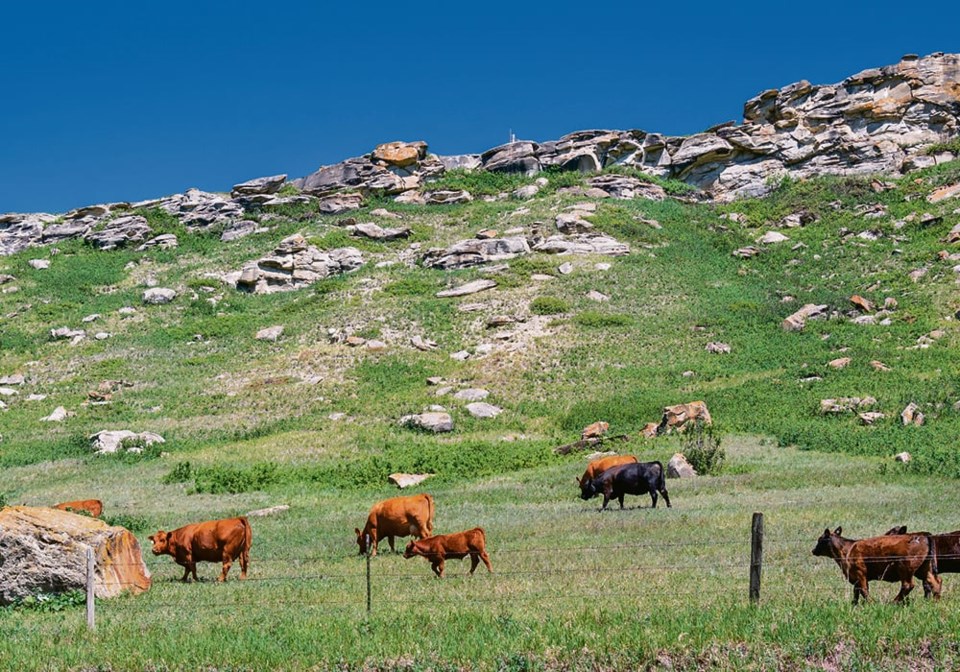Ranchers are accustomed to delays between a long day’s work and gratification for their efforts.
Often, a silent smile of self-gratification is the true reward when a calf earlier saved from a spring blizzard is loaded on the truck in the fall.
Other times, our efforts are not recognized, or worse, they are twisted into a narrative that suggests what we do is harmful.
Unfortunately, the cow-calf sector is viewed as a significant source of greenhouse gases by some. Ill-informed journalists, academics and politicians cite fossil fuel use, fertilization, enteric emissions and agricultural wastes as reasons to phase out the beef production industry and adopt alternative diets.
Rarely considered in this discussion is the atmospheric carbon sequestered and stored in the soil by the native rangelands, perennial forage crops, and annual crops used for silage, greenfeed and feedgrain.
Agricultural emission models often omit this sequestration factor, focusing on methane or nitrous oxide emissions and generating misleading emission figures.
This contributes to a negative public perception that can translate to detrimental regulations that may limit the financial prosperity of cow-calf producers. Not only is livestock production receiving no credit for being exceptional stewards of the land, producers are being penalized for it.
As well, ranchers have taken steps to improve soil health and sequester more carbon during the past 30 years, which are not considered when emission reduction targets are set. The adoption of no-till, rotational grazing and legume-based forage blends have helped lower cow-calf production emissions. Yet these practices go unrecognized and that will continue without a strong voice advocating for agriculture.
The consequences could paralyze the industry if public perception guides policymakers toward over-regulating beef production to comply with emission reduction targets generated without empirical evidence by one-sided science. Balancing the emissions equation with sound research serves as the starting point in illustrating the sequestration capacity of forage production soils.
Research from the University of Saskatchewan aims to change the narrative. In doing so, producers will be guided toward best practices to improve sustainability and profitability on their operations.
Further, the Canadian agricultural sector can use the information generated from the data to advise policymakers with science-backed information.
The 2023 Forage Production Survey has been developed by Stuart Smyth and his research team. By assembling data from 1991-94 and 2016-19 the team plans to build a dataset capable of showing how ranchers have taken steps to improve environmental sustainability.
The survey collects on-farm management data, encompassing all facets of forage production in the Saskatchewan cow-calf sector. The survey focuses primarily on forages produced for winterfeed, omitting livestock management practices, since enteric emissions and grazing are not relevant for the study.
The survey is composed of four components detailing forage seeding, in-crop input applications, forage harvesting and transportation. Upon completion of all four sections of the survey, producers are eligible to receive a $200 honorarium for their time.
Saskatchewan cow-calf producers can register to receive the online survey on dates throughout the summer at www.surveymonkey.com/r/forage-registration.
From the data, researchers intend to measure the steps Saskatchewan cattle producers have taken to improve the sustainability of the industry. This will be represented through changes in net carbon emissions between the time periods reported on the survey. Forage production epitomizes a vast and underappreciated tool to help reduce the agricultural carbon footprint.
All cow-calf producers in Saskatchewan are encouraged and eligible to participate. Although the survey asks about practices implemented in 1991-94 and in 2016-19, producers not active in the earlier period can complete the 2016-19 section.
Judson Christopherson is an M.Sc. student in the College of Agriculture and Bioresources’s Department of Agriculture and Resource Economics at the University of Saskatchewan. Stuart Smyth is an associate professor in the department.




